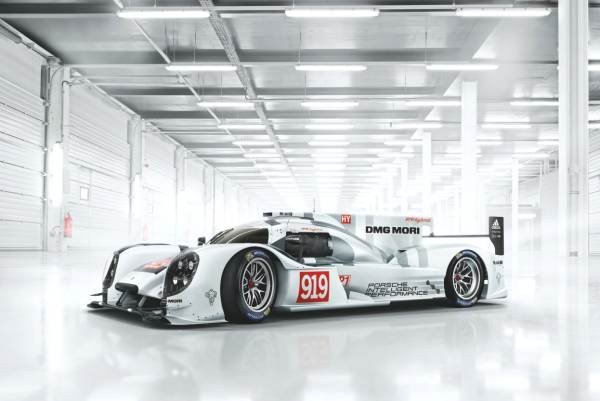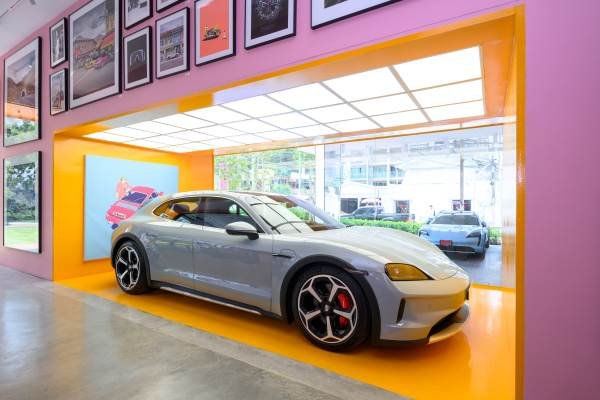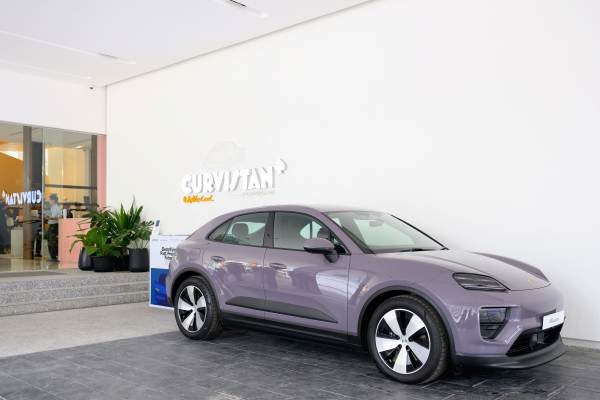เกือบ 125 ปีมาแล้ว เฟอร์ดินานด์ ปอร์เช่ (Ferdinand Porsche) ได้มีส่วนร่วมในการพัฒนายานยนต์ไฟฟ้าที่ขับเคลื่อนด้วยมอเตอร์ติดตั้งบนดุมล้อ (Wheel-Hub Motor) ซึ่งเทคโนโลยีนี้สร้างความฮือฮาอย่างมากในยุคนั้น และต่อมายังถูกนำไปใช้ในภารกิจบนดวงจันทร์เกือบ 70 ปีให้หลัง ปัจจุบัน ปอร์เช่ยังคงเป็นผู้นำด้านนวัตกรรมและขับเคลื่อนอนาคตของยานยนต์ไฟฟ้าอย่างต่อเนื่อง
การประดิษฐ์มอเตอร์ติดตั้งบนดุมล้อ – จุดเริ่มต้นของตำนาน
ในปี 1900 รถยนต์ไฟฟ้าที่ล้ำสมัยที่สุดในยุคนั้นเปิดตัวครั้งแรกภายใต้ชื่อ Lohner-Porsche ในงาน Paris Exposition ที่ Palace of Electricity การออกแบบระบบขับเคลื่อนอันแหวกแนวนี้ทำให้ชื่อของปอร์เช่เป็นที่รู้จักในวงกว้าง และถือเป็นเวทีแรกที่ เฟอร์ดินานด์ ปอร์เช่ วัย 24 ปี ได้เฉิดฉายในฐานะวิศวกรยานยนต์
ในเวลาเพียง 10 สัปดาห์ เขาได้พัฒนารถยนต์ไฟฟ้าสำหรับบริษัท Jacob Lohner & Co. ในกรุงเวียนนา โดย ติดตั้งมอเตอร์ไฟฟ้าขนาด 2.5 แรงม้า ที่ล้อหน้า 2 ล้อ ทำให้รถคันนี้ทำความเร็วสูงสุดได้ถึง 32 กม./ชม.
มอเตอร์ติดตั้งบนดุมล้อ (Wheel-Hub Motor) คือจุดเปลี่ยนสำคัญที่ทำให้ปอร์เช่ก้าวสู่ความสำเร็จครั้งแรก ในฐานะนักประดิษฐ์ยานยนต์ แม้ในช่วงเวลานั้น ปอร์เช่มองเห็นศักยภาพของเทคโนโลยีนี้ในโลกมอเตอร์สปอร์ต ซึ่งกำลังได้รับความนิยมอย่างสูง เขาจึงตัดสินใจ พัฒนารถแข่งพลังงานไฟฟ้าคันแรก โดยในปี 1900 เขาสร้างรถที่ติดตั้งมอเตอร์บนดุมล้อ 4 ตัว ให้กำลัง 14 แรงม้า ปอร์เช่ตั้งชื่อรถคันนี้ว่า “La Toujours Contente” ซึ่งแปลว่า “ผู้ที่มีความสุขเสมอ” และนี่ยังเป็นการสร้างรถขับเคลื่อน 4 ล้อไฟฟ้าคันแรกของโลก
Semper Vivus – รถยนต์ไฮบริดคันแรกของโลกที่ใช้งานได้จริง
จากแนวคิดระบบโมดูลาร์ เฟอร์ดินานด์ ปอร์เช่ เขาได้พัฒนารถยนต์ไฮบริดคันแรกของโลกที่สามารถใช้งานได้จริง ภายใต้ชื่อ Lohner-Porsche “Semper Vivus” ซึ่งในภาษาละตินแปลว่า “มีชีวิตเสมอ” ในยุคนั้น แบตเตอรี่ยังมีปัญหาบ่อยครั้ง และแทบไม่มีโครงสร้างพื้นฐานสำหรับการชาร์จไฟฟ้า การผสมผสาน เครื่องยนต์สันดาป (น้ำมัน) และ ไฟฟ้า จึงเป็น ทางเลือกที่สมเหตุสมผลและล้ำสมัยในยุคสมัยนั้น Semper Vivus และรุ่นที่พัฒนาต่อมาในปี 1901 ชื่อว่า Mixte ได้ผสานพลังจาก เครื่องยนต์ 4 สูบด้านหน้า และ เครื่องกำเนิดไฟฟ้า เพื่อสร้างแหล่งพลังงานไฟฟ้าบนล้อ ทำให้รถรุ่นนี้สามารถแก้ปัญหาด้านพลังงานในยุคนั้นได้อย่างชาญฉลาด ในที่สุด มีรถยนต์ Lohner-Porsche Mixte และ Semper Vivus ผลิตออกมาราว 300 คัน
เทคโนโลยี มอเตอร์ไฟฟ้าที่ติดตั้งบนดุมล้อ (Wheel-Hub Motor) ของปอร์เช่ กลับมาปรากฏอีกครั้งในช่วงต้นทศวรรษ 1970 ในภารกิจสำรวจดวงจันทร์ของ NASA –ในภารกิจ Apollo 15, 16 และ 17 รถสำรวจดวงจันทร์ทั้ง 3 คัน (Lunar Rovers) ใช้ระบบขับเคลื่อนด้วยมอเตอร์ไฟฟ้าบนดุมล้อ ซึ่งสามารถทำงานได้อย่างมีประสิทธิภาพภายใต้สภาพแวดล้อมบนดวงจันทร์

ปอร์เช่ 911 จีที3 อาร์ ไฮบริด (Porsche 911 GT3 R Hybrid) (2010)
ในปี 2010 ปอร์เช่กลับมาใช้แนวคิดการขับเคลื่อนแบบ “Mixte” อีกครั้ง พร้อมเปิดฉากใหม่ในประวัติศาสตร์ของรถแข่งตระกูล 911 ที่ประสบความสำเร็จอย่างสูง ด้วยการเปิดตัว 911 GT3 R Hybrid รถแข่งคันนี้ทำหน้าที่เป็นห้องทดลองเคลื่อนที่บนสนามแข่ง เพื่อทดสอบและพัฒนานวัตกรรมไฮบริดที่ล้ำสมัย ซึ่งแตกต่างอย่างชัดเจนจากแนวคิดไฮบริดในยุคนั้น ระบบขับเคลื่อนไฮบริดสุดล้ำที่ผสานไฟฟ้าและเครื่องยนต์เบนซิน เครื่องยนต์หลัก: เบนซิน 6 สูบนอน ขนาด 4.0 ลิตร วางหลัง เสริมด้วย: มอเตอร์ไฟฟ้า 2 ตัว ขับเคลื่อนล้อหน้า ระบบกักเก็บพลังงานด้วยฟลายวีล (Flywheel Energy Storage) ในช่วงเบรก มอเตอร์ไฟฟ้าจะทำหน้าที่เป็นเครื่องกำเนิดไฟฟ้า (Generator) ซึ่งจะสามารถฟื้นคืนพลังงานจลน์ (Kinetic Energy) และจะถูกส่งไปยังระบบฟลายวีลความเร็วสูง ซึ่งติดตั้งในโครงสร้างนิรภัยคาร์บอนไฟเบอร์ในห้องโดยสาร ฟลายวีลสามารถหมุนได้สูงถึง 40,000 รอบ/นาที หากผู้ขับขี่ต้องการเรียกใช้พลังงานที่เก็บสะสมไว้ ฟลายวีลจะถูกชะลอตัวในโหมดเครื่องกำเนิดไฟฟ้า และจ่ายพลังงานให้มอเตอร์ไฟฟ้าล้อหน้าได้นานสูงสุด 8 วินาที ผลลัพธ์คือ 911 GT3 R Hybrid กลายเป็น รถขับเคลื่อน 4 ล้อ (All-Wheel Drive) ชั่วขณะ เพิ่มแรงบิดและความเร้าใจอย่างมีประสิทธิภาพ
ปอร์เช่สามารถเลือกใช้ระบบขับเคลื่อนไฮบริด เพื่อเพิ่มสมรรถนะหรือเพิ่มประสิทธิภาพการใช้พลังงาน ได้ตามต้องการขึ้นอยู่กับสถานการณ์ในการแข่งขัน แม้ว่า ชัยชนะในการแข่งขัน 24 ชั่วโมงที่ Nürburgring จะไม่ใช่เป้าหมายหลักของ 911 GT3 R Hybrid ในการเปิดตัวครั้งแรกในปี 2010 แต่นวัตกรรมไฮบริดนี้ก็เกือบพารถแข่งคันนี้คว้าชัยชนะได้สำเร็จ แม้สุดท้ายรถจะต้องออกจากการแข่งขันก่อนกำหนด แต่ 911 GT3 R Hybrid ก็ได้พิสูจน์ให้เห็นอย่างชัดเจนว่า เทคโนโลยีไฮบริดของปอร์เช่มีความสามารถในการแข่งขันสูงอย่างยิ่งบนสนามแข่งระดับโลก นวัตกรรมที่ไม่เพียงแค่ทดลอง แต่พร้อมลงสนามจริง และพร้อมท้าทายทุกขีดจำกัด
ปอร์เช่ 918 สไปเดอร์ (Porsche 918 Spyder) (2013)
Porsche 918 Spyder ได้เปิดฉากยุคใหม่ของรถสปอร์ต ด้วยการผสมผสานระหว่าง สมรรถนะระดับซูเปอร์คาร์และความเป็นมิตรต่อสิ่งแวดล้อมอย่างไร้ที่ติ มอบพลังขับเคลื่อนอันทรงพลัง แต่ยังสามารถ แล่นอย่างเงียบสนิทปราศจากมลพิษในเมืองได้อย่างเหนือชั้น ด้วยระบบปลั๊กอินไฮบริดขั้นสูง 918 Spyder มีกำลังรวมถึง 652 กิโลวัตต์ (887 แรงม้า) ความเร็วสูงสุดที่ 345 กม./ชม. อัตราสิ้นเปลืองเชื้อเพลิงเฉลี่ยเพียง 3.1 ลิตร/100 กม. (มาตรฐาน NEDC) ในปี 2013 918 Spyder กลายเป็นรถสปอร์ตสายการผลิตรุ่นแรก ที่ทำเวลา ต่ำกว่า 7 นาที บนสนามแข่งระดับตำนาน Nürburgring Nordschleife ด้วยสถิติ 6 นาที 57 วินาที ความสำเร็จนี้มาจากแรงขับเพิ่มเติมจากมอเตอร์ไฟฟ้า 2 ตัว และ องค์ความรู้ด้านไฮบริดที่ต่อยอดมาจากการพัฒนา 911 GT3 R Hybrid
Porsche 918 Spyder มาพร้อม เครื่องยนต์ 3 ระบบที่ทำงานอย่างอิสระต่อกัน วางรากฐานให้กับแนวคิดระบบขับเคลื่อน 4 ล้อ (All-Wheel Drive) แบบใหม่ โดยใช้ศักยภาพสูงสุดจากทั้งระบบไฟฟ้าและเครื่องยนต์สันดาป รายละเอียดของขุมพลังทั้ง 3 ระบบได้แก่ เครื่องยนต์ V8 ขนาด 4.6 ลิตร 447 กิโลวัตต์ (608 แรงม้า) คือหัวใจหลักของระบบขับเคลื่อน เชื่อมต่อโดยตรงผ่าน คลัตช์แบบแห้ง (Dry Decoupler) เข้ากับ มอเตอร์ไฟฟ้า 115 กิโลวัตต์ (156 แรงม้า) ทั้งคู่สามารถขับเคลื่อนล้อหลังได้ แยกกันหรือพร้อมกัน ผ่านเกียร์อัตโนมัติ Porsche Doppelkupplung (PDK) แบบ 7 สปีด มอเตอร์ไฟฟ้าตัวที่สองทำงานแยกอิสระจากล้อหลังส่งกำลังสูงสุด 95 กิโลวัตต์ (129 แรงม้า) ไปยังล้อหน้า ด้วยโครงสร้างนี้ทำให้ 918 Spyder สามารถกลายเป็น รถขับเคลื่อน 4 ล้อชั่วคราว ที่ช่วยเพิ่มแรงยึดเกาะถนน และเสริมสมรรถนะด้านไดนามิกการขับขี่ นอกจากนี้ มอเตอร์ไฟฟ้าทั้งสองตัวยังสามารถชาร์จพลังงานกลับ (Regenerative Braking) เพิ่มประสิทธิภาพพลังงานโดยรวม
ปอร์เช่ 919 ไฮบริด (Porsche 919 Hybrid) (ปี 2014)
ประสบการณ์จากการพัฒนา 911 GT3 R Hybrid และ 918 Spyder มีอิทธิพลอย่างมากต่อการสร้างสรรค์รถแข่งรุ่นถัดไปอย่าง Porsche 919 Hybrid ในปี 2014 ปอร์เช่กลับสู่การแข่งขันระดับสูงสุดของโลกในรายการ World Endurance Championship (WEC) และ 24 Hours of Le Mans อย่างยิ่งใหญ่ ด้วย 919 Hybrid ด้วยกำลังขับเคลื่อนรวมกว่า 900 แรงม้า (662 กิโลวัตต์) Porsche 919 Hybrid กลายเป็น ห้องทดลองเคลื่อนที่ที่เร็วที่สุด และเป็นรถแข่งที่ล้ำหน้าที่สุดที่ปอร์เช่เคยสร้างขึ้น
เพื่อให้สอดคล้องกับกฎเทคนิคของการแข่งขัน WEC ปอร์เช่เลือกใช้แนวทางที่แตกต่างจากทีมอื่นในการพัฒนา ระบบขับเคลื่อนไฮบริดของ 919 Hybrid โดยใช้ระบบกู้คืนพลังงาน 2 รูปแบบที่ทำงานร่วมกัน ระบบแรก ดั้งเดิมแต่ทรงพลัง ดัดแปลงจาก 911 GT3 R Hybrid คือ มีเครื่องกำเนิดไฟฟ้าบนเพลาหน้า ทำหน้าที่เปลี่ยนพลังงานจลน์ขณะเบรกให้กลายเป็นพลังงานไฟฟ้า ระบบที่สอง ล้ำหน้าและแหวกแนว ใช้ชุดเทอร์ไบน์เจนเนอเรเตอร์เพิ่มเติม แทนที่ระบบเวสต์เกต (Wastegate) ทั่วไป พลังงานจากไอเสีย ซึ่งปกติจะสูญเปล่า ถูกนำมากลายเป็นพลังงานไฟฟ้า ผลลัพธ์คือ Porsche 919 Hybrid กลายเป็น รถแข่งเพียงคันเดียวในระดับ LMP1-H ที่สามารถกู้คืนพลังงานส่วนเกินได้ ทั้งขณะเบรกและขณะเร่งความเร็ว ขับเคลื่อนด้วยพลังงานที่เคยสูญเปล่า สู่สมรรถนะสูงสุดในสนามแข่ง
แบตเตอรี่ลิเธียมไอออนแบบระบายความร้อนด้วยของเหลว ที่พัฒนาขึ้นโดยปอร์เช่เอง ถูกเลือกใช้ใน 919 Hybrid เพราะมอบความสมดุลที่ดีที่สุดระหว่างการจ่ายไฟที่รวดเร็วและการดึงพลังงานที่ทรงพลัง ในช่วงเร่งความเร็ว พลังงานจากแบตเตอรี่จะถูกส่งไปยังเครื่องกำเนิดไฟฟ้าบนเพลาหน้า ซึ่งเปลี่ยนหน้าที่เป็นมอเตอร์ไฟฟ้าและขับเคลื่อนล้อหน้าทั้งสองผ่านระบบเฟืองท้าย สิ่งนี้ทำให้ Porsche 919 Hybrid กลายเป็นรถขับเคลื่อน 4 ล้อแบบชั่วคราว (Temporary All-Wheel Drive) โดยที่ เครื่องยนต์เบนซิน V4 ส่งกำลังขับเคลื่อนไปยังล้อหลังเพียงอย่างเดียว ผลลัพธ์คือสมรรถนะที่เหนือชั้นในทุกช่วงความเร็ว พร้อมการกระจายกำลังที่แม่นยำ และการยึดเกาะถนนสูงสุดในสนามแข่งขัน

ปอร์เช่ ไทคานน์ (Porsche Taycan) (2019)
“วันนี้ถือเป็นการเริ่มต้นของยุคใหม่” คำกล่าวของ ดร. โอลิเวอร์ บลูเม่ (Oliver Blume) ประธานคณะกรรมการบริหารของปอร์เช่ เอจี (Porsche AG) ในปี 2019 ระหว่างการเปิดตัวไทคานน์ (Taycan) ครั้งแรกของโลก ณ กรุงเบอร์ลิน Taycan คือ รถสปอร์ตพลังงานไฟฟ้าซาลูน 4 ประตูเต็มรูปแบบ ที่ผสานสมรรถนะระดับปอร์เช่กับการเชื่อมต่อดิจิทัลและความสะดวกสบายสำหรับการใช้งานในชีวิตประจำวัน อย่างไร้ที่ติ แนวทางใหม่ทั้งในด้านการผลิตและความยั่งยืน วิธีการผลิตที่ทันสมัยขั้นสูง และคุณสมบัติล้ำสมัย Taycan ได้ สร้างมาตรฐานใหม่ในด้านความยั่งยืนและดิจิทัล ในอุตสาหกรรมยานยนต์ รุ่นแรกที่เปิดตัวในไลน์คือ Taycan Turbo S และ Taycan Turbo ซึ่งเป็นรุ่น เรือธงของสมรรถนะไฟฟ้าในแบบ Porsche E-Performance ทั้งคู่จัดอยู่ในกลุ่มรถสายการผลิตที่ทรงพลังที่สุด เท่าที่ปอร์เช่เคยมีมาในเวลานั้น
Taycan คือรถยนต์สายการผลิตคันแรกของโลกที่ใช้ ระบบไฟฟ้าแรงดัน 800 โวลต์ แทนที่จะเป็น 400 โวลต์ ซึ่งเป็นมาตรฐานทั่วไปในรถยนต์ไฟฟ้า ข้อได้เปรียบนี้มอบประสบการณ์เหนือระดับให้กับผู้ขับขี่ Taycan โดยเฉพาะเมื่อต้องชาร์จระหว่างเดินทาง เพียง 5 นาที สามารถชาร์จไฟจากเครือข่ายชาร์จเร็วพลังสูง (High-Power Charging) เพื่อวิ่งต่อได้ สูงสุด 100 กิโลเมตร (ตามมาตรฐาน WLTP) เวลาชาร์จ 5% ถึง 80% อยู่ที่ 22.5 นาที ในสภาวะที่เหมาะสม โดยมี กำลังชาร์จสูงสุด (Peak) ถึง 270 kW สำหรับการชาร์จที่บ้าน ผู้ขับขี่สามารถชาร์จรถได้อย่างสะดวกด้วยกำลังไฟสูงสุด 11 kW ดีไซน์ล้ำสมัย สะท้อนจุดเริ่มต้นแห่งยุคใหม่ด้วยดีไซน์ที่สะอาดตาและเน้นความเรียบหรู Taycan คือสัญลักษณ์แห่ง การเริ่มต้นยุคใหม่ของปอร์เช่ ขณะเดียวกัน Taycan ยังคง DNA การออกแบบของปอร์เช่อย่างชัดเจน Porsche Taycan คือ พลังแห่งอนาคต พร้อมความเป็นปอร์เช่ที่แท้จริง
ปอร์เช่ ไทคานน์ (Porsche Taycan) รุ่นปรับโฉม (2024)
ต้นปี 2024 ปอร์เช่ได้ปรับโฉม Taycan ครั้งใหญ่ ด้วยดีไซน์ที่เฉียบคมขึ้น สมรรถนะที่แรงขึ้น ระยะทางวิ่งที่ไกลขึ้น และเทคโนโลยีการชาร์จที่รวดเร็วยิ่งขึ้น Taycan GTS รุ่นใหม่ สร้างขึ้นจากเรื่องราวความสำเร็จที่ครอบคลุมทุกโมเดลของ Gran Turismo Sport ที่โดดเด่นทั้งในด้านดีไซน์และสมรรถนะ ในขณะที่ Taycan รุ่นเริ่มต้น (Entry-Level) ก็เปิดตัวเวอร์ชัน ขับเคลื่อน 4 ล้อ (All-Wheel Drive) เป็นครั้งแรก ไลน์อัป Taycan ที่หลากหลายที่สุดเท่าที่เคยมีมา เพราะมีให้เลือกถึง 3 ตัวถัง ได้แก่ Sedan, Sport Turismo และ Cross Turismo ระบบขับเคลื่อนทั้งแบบ ล้อหลัง (RWD) และ 4 ล้อ (AWD) สมรรถนะมอเตอร์ไฟฟ้าในระดับ 300 ถึง 760 กิโลวัตต์รวมทั้งหมด 16 รุ่นย่อย เพื่อตอบโจทย์ทุกสไตล์ของผู้ขับขี่ Taycan รุ่นใหม่ – แรงกว่า ไกลกว่า ชาร์จไวกว่า พร้อมดีไซน์ที่ยังคง DNA ของปอร์เช่ไว้อย่างชัดเจน
Taycan เจเนอเรชัน 2 ได้รับการพัฒนาให้ เหนือกว่ารุ่นก่อนหน้าในแทบทุกด้าน ทั้งด้านกำลังขับเคลื่อน ระยะทางขับขี่ การเร่งความเร็ว ไปจนถึง ความเร็วในการชาร์จไฟ ที่เสถียรยิ่งขึ้น สมรรถนะและประสิทธิภาพที่พัฒนาขึ้น พร้อมกันอย่างลงตัว ความก้าวหน้านี้เกิดจากการปรับปรุงในหลายองค์ประกอบหลัก ทั้ง
ระบบขับเคลื่อนที่ทันสมัย พร้อมมอเตอร์ล้อหลังที่ให้กำลังเพิ่มขึ้นสูงสุดถึง 80 กิโลวัตต์ เมื่อเทียบกับรุ่นก่อน หน้าในทุกรุ่น Pulse Inverter รุ่นใหม่ ที่มาพร้อมซอฟต์แวร์ที่ถูกปรับแต่งให้มีประสิทธิภาพสูงขึ้น แบตเตอรี่ทรงพลังยิ่งกว่าเดิม พร้อมการจัดการความร้อนที่แม่นยำยิ่งขึ้น Heat Pump เจเนอเรชันใหม่ ที่ให้ประสิทธิภาพสูงขึ้นในทุกสภาพอากาศ รวมถึงการปรับปรุง ระบบชาร์จกลับพลังงาน (Recuperation) และ กลยุทธ์การทำงานของระบบขับเคลื่อน 4 ล้อ เพื่อเพิ่มสมรรถนะและประหยัดพลังงานยิ่งขึ้น

Porsche Pioneer and Innovator of E-Mobility
Almost 125 years ago, Ferdinand Porsche was involved in the development of an electric vehicle powered by a wheel-hub motor. The technology became a sensation – and even landed on the moon almost 70 years later. Today, Porsche is just as innovative and still at the forefront of innovating e-mobility.
Inventing the wheel-hub motor
In 1900, a groundbreaking electric car, based on the Lohner-Porsche system, celebrated its premiere at the Paris Exposition’s Palace of Electricity. The innovative drive concept brought widespread recognition of the Porsche name and was 24-year-old Ferdinand Porsche’s first foray into the limelight as an automotive engineer. For the company Jacob Lohner & Co., based in Vienna, he developed an electric vehicle with wheel-hub motors integrated into the front wheels in just ten weeks. Each of the two electric motors delivered 2.5 PS and the top speed of the Lohner-Porsche was 32 km/h.
The wheel-hub motor was Porsche’s breakthrough. Even then, Porsche considered the idea of using the technology in motorsports, as racing already enjoyed high popularity at that time. Consequently, in the year 1900 he completed an electric race car with four wheel-hub motors, each of which delivered 14 PS. He christened the car “La Toujours Contente” (the one who is always happy) and had built the world’s first all-wheel drive vehicle.
Semper Vivus – The world’s first functional hybrid car
On the basis of his modular system, Porsche also developed the world’s first functional hybrid car, the Lohner-Porsche “Semper Vivus” (Latin for “always alive”). The concept of combining gas-powered and electric drive was a logical step because the batteries frequently caused problems and a charging infrastructure was virtually nonexistent. The Semper Vivus hybrid and the Mixte, the optimized version of the series from 1901, resolved these issues by combining the four-cylinder front engine with a generator to create a mobile electricity supplier. Around 300 vehicles were ultimately produced. While, at the time, other concepts were better suited for mass production, the wheel-hub motor technology reappeared in the early 1970s: NASA’s three lunar rovers of the Apollo missions 15, 16, and 17 were powered by electric wheel-hub motors – thanks, in part, to Porsche’s pioneering work.
Porsche 911 GT3 R Hybrid (2010)
In 2010, Porsche returned to the visionary “Mixte” drive concept. The sports car manufacturer once again used the race track as a test laboratory and opened a new chapter in the 911’s extraordinarily successful motorsports history with the 911 GT3 R Hybrid. The test vehicle’s hybrid system differed significantly from traditional concepts at that time. A front-axle drive with two electric motors supplemented the 4.0 litre six-cylinder flat engine in the rear. In braking phases the electric units reversed their function and worked as generators. As a result, they regained kinetic energy that otherwise would have been dispersed as waste heat. The recuperated energy drove a mechanical flywheel energy storage system which was located in a carbon-fibre safety cell in the passenger space. The system achieved rotation speeds of 40,000 rpm. If the driver called up the energy saved there, the flywheel was electromagnetically decelerated in generator mode, providing additional power to the two electric motors on the front axle for up to eight seconds. As a result, the 911 GT3 R Hybrid was temporarily transformed into an all-wheel drive vehicle.
Depending on the racing situation, Porsche could use the hybrid drive to improve either performance or consumption. Although a victory by the 911 GT3 R Hybrid at the 24-hour race on the Nürburgring was not the primary goal, the innovative technology almost succeeded in doing so at its premiere in 2010. Although it retired prematurely, the 911 GT3 R Hybrid had proved that the hybrid technology developed by Porsche was extremely competitive on the race track.
Porsche 918 Spyder (2013)
The 918 Spyder ushered in a new era of sports cars. It offered high performance but could also glide through the city exhaust-free and virtually without a sound. Thanks to its advanced plug-in hybrid design, it combined a system performance of 652 kW (887 hp) with a top speed of 345 km/h and an NEDC average fuel consumption of 3.1 litres/100 km. In 2013, the 918 Spyder became the first series-production sports car to break the seven-minute barrier on the Nürburgring Nordschleife. Its record lap time of 6.57 minutes was due, among other factors, to the additional thrust of its two electric motors and the hybrid knowledge previously gained with the 911 GT3 R Hybrid.
The 918 Spyder’s three independent engines set the stage for a unique all-wheel drive concept by exploiting all the possibilities of the combined drive. A 4.6 litre and 447 kW (608 hp) high-revving V8 engine formed the basis of the concept. By means of a dry decoupler, it connected directly to a parallel-switched electric motor with 115 kW (156 hp). Both could power the rear axle either individually or jointly via a seven-speed Porsche Doppelkupplung (PDK). The second electric drive operated mechanically, independently of the rear axle. Via a transmission with a constant gear ratio, it sent up to 95 kW (129 hp) to the front wheels. This meant that the 918 had a temporary all-wheel drive that improved traction and offered advantages in terms of driving dynamics. In addition to boosting, both electric units could also regain energy.
Porsche 919 Hybrid (since 2014)
The experiences with the 911 GT3 R Hybrid and the 918 Spyder also influenced the development of the Porsche 919 Hybrid. With it, the sports car brand returned to the top class of the World Endurance Championship (WEC) in 2014, and therefore also to the 24 Hours of Le Mans. With a system performance of over 900 hp (662 kW), the 919 Hybrid was the fastest test laboratory and the most innovative racing car that Porsche has ever built.
In view of the WEC technical regulations, Porsche chose an unusual path: The hybrid drive was based on two different energy recovery systems. The first worked conventionally and was derived from the 911 GT3 R hybrid: A generator on the front axle transforms kinetic energy into electrical energy in braking phases. The second was more advanced: an additional turbine generator unit takes on the task of the wastegate. From exhaust gas energy, which was previously lost, the unit generates electrical current. As a result, the Porsche 919 Hybrid was the only sports car in the LMP1-H top class that recovered excess energy not only during braking, but also during acceleration.
The self-developed, liquid-cooled lithium-ion batteries offered the best compromise between fast power consumption and power output. In acceleration phases their energy flowed to the front generator, which then functions as a single electric motor and drove both front wheels via a differential. This gave the Porsche 919 Hybrid a temporary all-wheel drive, because the power of the four-cylinder V-combustion engine went to the rear axle alone.
Porsche Taycan 2019
“This day marks the start of a new era,” said Oliver Blume, Chairman of the Executive Board of Porsche AG, in 2019 at the Taycan’s world premiere in Berlin: The four-door sports saloon was a unique package, offering typical Porsche performance and connectivity with everyday usability. At the same time, highly advanced production methods and the features of the Taycan were setting new standards in the fields of sustainability and digitalization. The first models in the new series were the Taycan Turbo S and Taycan Turbo. They were at the cutting edge of Porsche E-Performance and were among the most powerful production models that the sports car manufacturer had in its product range.
The Taycan was the first production vehicle with a system voltage of 800 volts instead of the usual 400 volts for electric cars. This was a particular advantage for Taycan drivers on the road: in just over five minutes, the battery could be recharged from the high-power charging network for a range of up to 100 kilometers (according to WLTP). The charging time for five to 80 percent SoC (state of charge) was 22.5 minutes for charging under ideal conditions, and the maximum charging power (peak) was 270 kW. Taycan drivers could comfortably charge their cars with up to eleven kW at home. With its clean, puristic design, the Taycan signaled the beginning of a new era. At the same time, it retained the unmistakable Porsche design DNA.
Porsche Taycan, second generation 2024
With a sharper design, more power, more range and even better charging performance, Porsche extensively modernised the Taycan at the beginning of 2024. The new edition of the Taycan GTS built on the model-spanning success story that is the Gran Turismo Sport at Porsche, whereas the entry-level sports sedan was now also available with all-wheel drive for the first time. The range of Taycan models had never been wider: with three body variants, all-wheel and rear-wheel drive and various power levels of the Porsche E-Performance motors ranging from 300 to 760 kW, there were 16 versions overall.
The electric sports car surpassed its predecessor in almost every discipline. The new models had more power, longer range, accelerated faster and charged in less time with greater stability. The simultaneous improvement of performance and efficiency was down to a number of factors: an advanced powertrain with a new rear-axle motor with up to 80 kW more power than its predecessor on all models, a modified pulse inverter with optimized software, more powerful batteries, revised thermal management, a next-generation heat pump and a modified recuperation and all-wheel-drive strategy.








